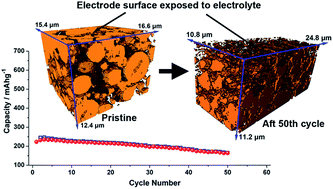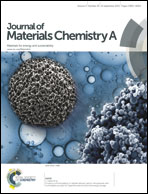Nano-structural changes in Li-ion battery cathodes during cycling revealed by FIB-SEM serial sectioning tomography†
Abstract
The growing demand for reliable, durable electrical energy systems to power electric and hybrid vehicles motivates worldwide efforts aimed at developing high-energy, high-power density batteries. One of the obstacles to widespread industry adoption is the lack of profound understanding and the ability to monitor and control the long-term degradation and capacity fading observed in these systems. Focused Ion Beam-Scanning Electron Microscopy (FIB-SEM) serial sectioning is used to reconstruct the evolution of the three-dimensional structure of Li-ion battery electrodes during extended cycling. High resolution imaging reveals microstructural information at the level of the composite framework consisting of the spheroidal micro-particles of the active material held together by the polymer matrix. The evolution of damage within the micro-particles of the active material can be seen in the form of voiding, cracking and ultimate fragmentation. In particular, when spherical micro-particles of Li-rich layered oxides are used as the cathode, it is found that the extent of fragmentation varied in the direction of Li+ diffusion current from the particle surface inwards. We use a simple model of the strain and strain gradient effects of Li+ transient diffusion within the electrode to identify the driving force for particle fragmentation, and discuss the implication of these results.


 Please wait while we load your content...
Please wait while we load your content...